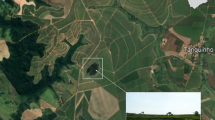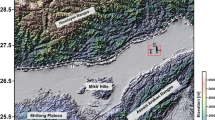Abstract
The issue of seepage and its management is essential in earth dams which if exceeded from a certain stage the destruction of dam is probable. Despite the studies run through consulting engineers, the hydraulic behaviors of both body and foundation cannot be predicted. To understand the function of such structures, the geotechnical software PLAXIS 3D based on FEM is applied to determine the transient seepage analysis on the subject earth dam for 1 year. The outputs in downstream drain are compared with the actual obtained results from seepage at the same points with 15-day intervals for 1 year as an experimental sample. The obtained data here thorough PLAXIS 3D in addition to available actual seepage, permeability coefficients in x, y, and z directions, transient head upstream, soil-specific gravity for both the wet and dry conditions, Poisson coefficient, c, ɸ, and elasticity modulus material are trained through a neural network algorithm. Here, an equation is yield through which the seepage is calculated in transient head upstream at any point of the subject earth dam. This equation has a great accuracy of (P value > 0.05), and is applied in calculating the actual seepage of earth dams in critical situations such as earth dam failure due to piping operation or dam body erosion.



Similar content being viewed by others
References
Abd A, Senon A (2011) Analytical solution for seepage in dams with central core by PALAXIS Software. Water Resour Manag. https://doi.org/10.1016/j.aej.2010.10.001
Ahmadi B, Ismaeli K, Tavossi M (1392) Selection of the optimal method of sealing dams (Case Study: Binalud earth dam). In: The seventh international congress of Zahedan University, Zahedan, Iran
Bayat M, Eslamian S, Shams G, Hajiannia A (2017) Numerical study of seepage for KORD-OLIYA dam and compare by using actual data. In: 2nd international conference of modern approaches in science, technology and engineering, Paris, France
Chen YF, Zhou CB, Zheng H (2008) A numerical solution to seepage problems with complex drainage systems. Compute Geotech 35:383–393
Davis PA, Olague NE, Goodrich MT (1992) Application of validation strategy to Darcy’s experiment. Adv Water Resour 15:175–180
Lam L, Fredlund D (1984) Saturated-unsaturated transient finite element seepage model for geotechnical engineering. Adv Water Resour 7:132–136. https://doi.org/10.1016/0309-1708(84)90042-3
Lee JY, Choi YK, Kim HS, Yun ST (2005) Hydrologic characteristics of a large rockfill dam: implications for water leakage. Eng Geol 80:43–59 (in Amsterdam, The Netherlands)
Najafpour N, Shayan NM, Samadi H (2012) Determine the pattern of pipelines seep and Drainage design earth dams on the follow-impermeable foundation using physical models and software PLAXIS. J Water Soil 28:461
Ren J, Shen Z, Yang J, Yu C (2016) Back analysis of the 3D seepage problem and its engineering applications. Env Earth Sci 75:113–121
Richardson A, Fry L (1922) Weather prediction by numerical Process. The University press, Cambridge, pp 262
Shivakumar S, Athania Shivamantha H, Solankia Q, Dodagoudarb GR (2015) Seepage and stability analyses of earth dam using finite element method. World Env Water Resour Congr 4:876–883. https://doi.org/10.1016/j.aqpro.2015.02.110
Toromanović J, Mattson H, Knutsson S (2016) Effects on an earth- and rock fill dam undergoing dam safety measures. Chall Nordic Geotech 2016:25–28
Unal B, Eren M, Yalcin MG (2007) Investigation of leakage at Ataturk dam and hydroelectric power plant by means of hydrometric measurements. Eng Geol 93:45–63 (in Amsterdam)
Venkatesh K, Karumanchi S (2016) Distribution of pore water pressure in an earthen dam considering unsaturated-saturated seepage analysis. In: E3S web of conferences. https://doi.org/10.1051/e3sconf/20160919004
Wu LZ, Liu GG, Wang LC, Zhang LM, Li BE, Li B (2016) Numerical analysis of 1D coupled infiltration and deformation in layered unsaturated porous medium. Env Earth Sci 75:761
Wu LZ, Zhou Y, Sun P, Shi JS, Liu GG, Bai LY (2017) Laboratory characterization of rainfall-induced loess slope failure. CATENA 150:1–8
Zhang LM, Chen Q (2006) Seepage failure mechanism of the Gouhou rockfill dam during reservoir water infiltration. Soils Found 46(5):557–568
Author information
Authors and Affiliations
Corresponding author
Additional information
Publisher's Note
Springer Nature remains neutral with regard to jurisdictional claims in published maps and institutional affiliations.
Rights and permissions
About this article
Cite this article
Bayat, M., Eslamian, S., Shams, G. et al. The 3D analysis and estimation of transient seepage in earth dams through PLAXIS 3D software: neural network. Environ Earth Sci 78, 571 (2019). https://doi.org/10.1007/s12665-019-8405-y
Received:
Accepted:
Published:
DOI: https://doi.org/10.1007/s12665-019-8405-y




